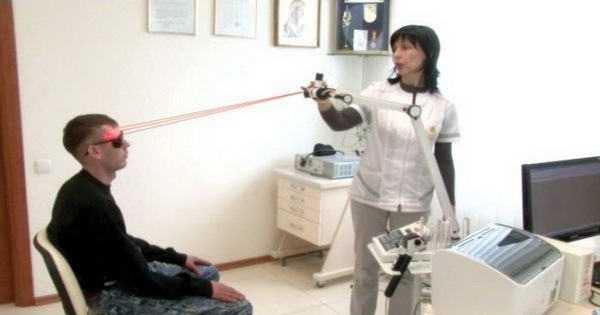Schizoaffective disorder
 Schizoaffective disorder is a disorder characterized by symptoms of schizophrenia and mood disorders, which are expressed to an equal degree. And they develop as a rule evenly. Also, this disease can develop after depression, or psychosis.
Schizoaffective disorder is a disorder characterized by symptoms of schizophrenia and mood disorders, which are expressed to an equal degree. And they develop as a rule evenly. Also, this disease can develop after depression, or psychosis.
Causes of
One exact cause of this disorder is not established, therefore it is accepted as reasons to isolate: genetic, biochemical, environmental factors.
Genetic: the disease is transmitted to children from their parents, or in 3 generations from grandparents.
Chemical: people who suffer psychoses for a long time, face a problem called: imbalance chem. Substances in the brain. Chemicals promote the transmission of messages through the brain cells, and when they are not enough, this transmission is disrupted and symptoms of the disease appear.
Environmental factors: according to evidence, this may include viral infections, namely after the treatment of viral infections, as a complication will be schizoaffective disorder. Also, the isolation of a person in society, not the desire to communicate with people or simply not the ability to start a conversation or join a new team. An important cause of the external environment is a strong psychological disorder or severe stress resulting from illness or accident, this refers to genetically predisposed people to this disease.
Schizoaffective disorder most often develops in adolescents, it is the transitional age that affects the development of the emotional environment of a person. And also at this age, all problems seem to be unresolved, so teenagers get stressed, and as a consequence, schizoaffective disorder.
According to doctors, each person experiences such a disorder in a certain period of his life.
Symptoms of
Symptoms and symptoms of schizoaffective disorder include symptoms that are manifested in three diseases: schizophrenia, depression, mania. These symptoms can manifest simultaneously, but can alternate.
- Symptoms characteristic of schizophrenia:
- Hallucinations, a person hears something that is not really there.
- Persistent nonsense. The patient, for example, claims to be communicating with aliens.
- Inadequacy.
- Symptoms, characteristic depression.
Manifestations of emotions of each person are various. These include: sadness, anxiety, low self-esteem.
A person who is in a state of depression, constantly tired, sad, nothing pleases him. He becomes indifferent to everything, no life circumstances please him. Also, a person loses his ability to act, can not pay due attention to his ordinary affairs. About himself, a person thinks only bad, considers himself to be useless to nobody. Practically can not make decisions independently.
Symptoms, characteristic mania
Symptoms, characteristic mania develop rapidly, usually this time takes two to three days. In the early stages of the disease, a person in a good mood, feels better than everyone, begins to work better, show initiative in business. The condition of a person is happy, there is euphoria. Another important symptom is not the concentration of a person in one case, he often can not finish the job to the end, but begins another.
In very dangerous cases, a logical connection is lost. In this case, the patient needs hospitalization.
Psychotic symptoms can correspond to mood, and can and vice versa. The course can be in the form of remissions or exacerbations, which lead to an aggravation of personality. In schizoaffective disorders, there are attempts at suicide, a specific number of them is not established, but approximately this is ten percent of all cases of suicide.
Diagnostics
Before the diagnosis of schizoaffective disorder, the patient must undergo a complete examination of the body. There is information about the development of the disease. Consider the patient's illnesses, which he suffered during life. Also here include chronic pathologies, pregnancy, surgery and heredity of the patient.
The diagnosis is made only if the patient simultaneously has symptoms of schizophrenia and symptoms of affective disorder. Also, a diagnosis can be made immediately if a person already has a mental illness different from schizophrenia, as well as an affective disorder.
The diagnosis of this schizoaffective disorder can not be established if a person has had a serious illness and this condition is caused by taking medications. Moreover, to establish this disorder, a person should not have an anamnesis of another schizophrenic disease.
Treatment
Usually people with schizoaffective disorder categorically refuse treatment. If you notice your friend's symptoms of this disease, you should gently persuade him to seek help from a doctor.
Treatment will be more effective if medication is combined with psycho-correction. Usually medicines are prescribed in order to suppress a depressive state, to normalize the mood and to get a person out of depression.
For treatment, such drugs are prescribed:
Soothing
Soothing drugs are prescribed to suppress depression, as well as symptoms such as nonsense, paranoia. This includes drugs: clozapine, olanzapine, as well as herbion and soothing teas.
Stabilizers
They are prescribed for bipolar disorder. They help to stabilize the mood. And to keep in normal manifestations of the disease as mania, depression, low self-esteem. This includes such drugs as: mikalit, litonite, etc.
Antidepressants
For depressive disorders, antidepressants are prescribed. They take away the feeling of sadness, of hopelessness. A person who is depressed thinks that nobody needs him. Drugs allow you to achieve the state of "need" for others. They improve attention, memory, promote normal, healthy sleep.
Often the treatment is not medication, here the following methods are classified.
Psychotherapy
The physician sets up a trust relationship with the patient. Trying to achieve a sense of trust, in some cases of friendly relations. During the sessions of psychotherapy, the patient learns to build life plans, solve problems independently, without the help of others, and also try to establish relationships in society. It can be a relationship at work, and in the family, as well as just on the street. For example: talking in the store or in the entrance. The patient should learn new behavior strategies that will contribute to more effective communication.
Family therapy, or therapy in the
group Treatment will be more effective if people with such disorders have the opportunity to communicate with each other. They will share their problems, talk about the course of the disease, their lives and problems.
Also the appearance of a support group by relatives and friends will positively affect the patient. First, they will establish control over the patient, will observe changes in his behavior, and secondly, reduce the social isolation of the patient. That is, in the process of communicating with relatives, the patient will learn to communicate in society, and also try to feel the same as everyone else.
Patients with schizoaffective disorders require long-term treatment, the result of which is almost impossible to predict in advance.



